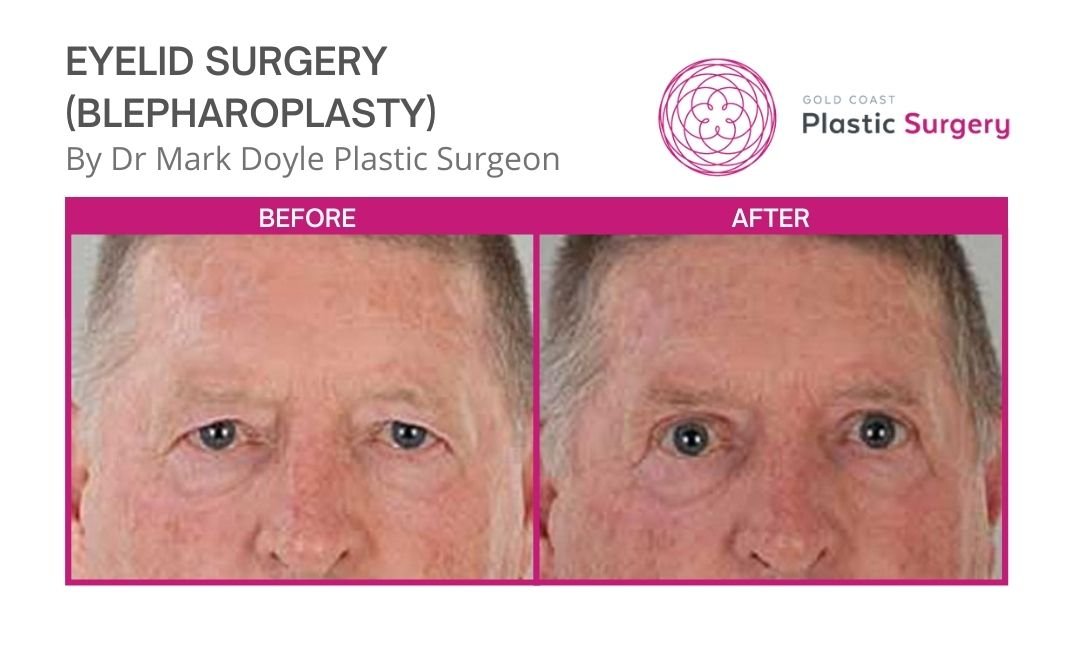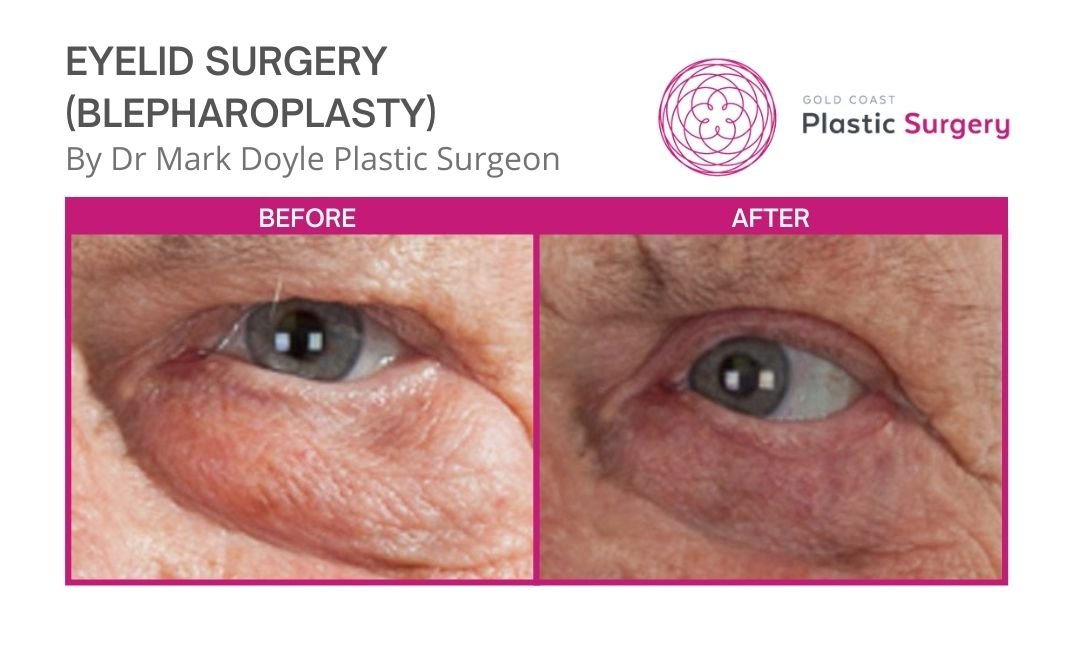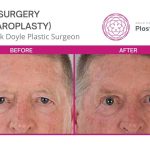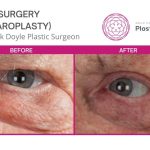Medicare Criteria and Rebates for Eyelid Lift Cosmetic Surgery (Blepharoplasty Rebates)
Over time, you may have noticed that your eyelids are not what they used to be. They may droop or sag, making you appear older or more tired than you really are. Blepharoplasty surgery (eyelid lift) can be performed on the upper or lower (or both) eyelids to widen the appearance of the eyes. This typically results in a refreshed appearance. But when does eyelid surgery become medically necessary? In order for Medicare to cover your Eyelid surgery, you must meet a very stringent set of criteria outlined in the Medicare Benefits Schedule (MBS).
Is Eyelid Surgery Always Covered by Medicare?
Blepharoplasty or eyelid surgery may attract Medicare rebates and private health fund cover if it is performed for medical reasons ONLY.
The Medicare Benefits Schedule code or item number 45617 for Upper Eyelid Surgery covers the condition involving ptotic (drooping) eyelid skin. For Medicare funding, your upper eyelid skin must droop significantly and have an impact on your field of vision. If your eyelid skin makes it difficult to see, and you require eyelid ptosis surgery to relieve this, you may be eligible for a Medicare rebate on your Eyelid Surgery (Blepharoplasty) procedure. You will be required to take a visual field test by an opthalmologist to prove this.
If the surgery is performed to reconstruct eyelid cancer defects, improve accidental injuries, birth deformities and eyelid malpositions such as entropion and ectropion, it is considered medical and will attract a Medicare benefit and private health cover.
During your initial consultation with Specialist Plastic Surgeon Dr Doyle, he will give you an indication of whether or not you satisfy the criteria for medically necessary eyelid surgery. To receive a Medicare item number immediately, you will need to show evidence that demonstrates the clinical need for eyelid surgery. This includes reports from an optometrist or ophthalmologist.
How Much Will Medicare Contribute Towards My Blepharoplasty?
It’s important to know that Medicare won’t subsidise the cost of the entire procedure. Instead, Medicare covers 75% of the fees outlined in the Medicare Benefits Schedule. These fees are commonly lower than the costs of the procedure.
Benefits of Receiving a Medicare Rebate for Eyelid Surgery
The biggest benefit of receiving a Medicare rebate is the reduction in the total out of pocket costs for your medically necessary eyelid surgery.
This is because Private Health Insurance is required to assist with the cost of medical services that fall under the guidelines of the MBS. So, if you attract a Medicare code for Blepharoplasty, you may be covered for private patient hospital cover, general cover (commonly known as extras), or combined hospital and general cover.
This typically requires a comprehensive or “top cover” policy. We advise that you check with your private health fund if your plan covers you for the procedure.
What Happens to the Eyelids With Age?
The sensitive eye area is one of the first body parts to show early signs of aging. Aging impacts the bone of the eye socket as well as the eyelid muscles – which weaken with time.
Superficially, age and long-term sun exposure impact the appearance of the skin and fat around the eyes. This can make you appear tired, sad or angry, regardless of your actual emotions. When these changes become severe, they can impact your vision. Common ageing changes include:
Upper Eyelid
- Thin excess eyelid skin that appears loose and crepey
- Eyelid skin that rests on your eyelashes
- Saggy or droopy upper eyelid skin (ptosis) which causes a tired looking eyes
- Excess fat that sags or bulges causing a ‘full’ upper eye look
- Hollow and sunken eyelids due to fat retracting into the eye socket
- Eyelid crease that appears absent or very high
- Asymmetrical eyelid crease
Lower Eyelid
Ageing changes in the lower eyelid are a result of the under-eye bone shrinking with age. This can cause the appearance of bulging eye bags, deepening of the undereye groove or loose and saggy lower eyelids. Common ageing changes include:
- Thin and crepey skin in excess
- Bulging fat which causes eye bags
- Hollowing under the eye due to loss of bone and soft tissue
- The lower eyelid appears ‘pulled down’
- Droopy corners of the eyelid causing a sad look
- The edge of the lower eyelid turns out due to muscle weakness (ectropion)
- The edge of the lower eyelid turns in due to muscle over-activity (entropion)
Fortunately, blepharoplasty can be performed on either the upper eyelids or the lower eyelids (or both) to reverse these common concerns. This procedure is performed by Specialist Plastic Surgeon Dr Doyle at John Flynn Private Hospital. It involves removing the excess fat or skin around the eyelids and tightening the loose muscle if required.
Will Medicare Cover My Eyelid Surgery?
If your Blepharoplasty surgery is being performed out of medical necessity, Medicare may cover a portion of the cost of your Eyelid surgery. Some of your costs may also be covered by a partial rebate from your Private Health Fund if you have sufficient cover.
It’s important to know that the criteria to receive a rebate is very strict and may require extensive assessments, medical visits, photographs and testing to take place for approval.
Medical indications for the necessity of Eyelid Surgery include:
- Your eyelid skin has lost its collagen, firmness or elasticity causing it to droop over the eyelashes and impede your vision. This leads to a tired or angry look as well as vision impairment from an obscured iris (obstructed vision).
- If your eyelid impacts the field of vision, eye function and health of the eye area, you may be eligible for a rebate.
- Your Eye Doctor and/or Surgeon must assess this and report on this before eligibility for a rebate is determined. This is done by doing a visual field eye test by an optometrist or ophthalmologist.
Medically Indicated Eyelid Surgery (Blepharoplasty) occurs when:
- The sagging of the eyelid (skin redundancy) becomes so extensive that vision becomes obscured (visual field defect), or
- Intertriginous inflammation of the eyelid
The photos below are of actual patients who had a medical need for corrective upper Blepharoplasty due to eyelid ptosis impeding their vision.
If you would like to see more Eyelid Lift Before and After photos from Dr Doyle, click here.
Medicare Item Numbers for Eyelid Surgery
- Item Number 45617
Upper eyelid, reduction of, if:
(a) the reduction is for any of the following:
(i) skin redundancy that causes a visual field defect (confirmed by an optometrist or ophthalmologist) or intertriginous inflammation of the eyelid;
(ii) herniation of orbital fat in exophthalmos;
(iii) facial nerve palsy;
(iv) post-traumatic scarring;
(v) the restoration of symmetry of contralateral upper eyelid in respect of one of the conditions mentioned in subparagraphs (i) to (iv); and
(b) photographic and/or diagnostic imaging evidence demonstrating the clinical need for this service is documented in the patient notes
- Item Number 45620
Lower eyelid, reduction of, if:
(a) the reduction is for:
(i) herniation of orbital fat in exophthalmos, facial nerve palsy or post-traumatic scarring; or
(ii) the restoration of symmetry of the contralateral lower eyelid in respect of one of these conditions; and
(b) photographic and/or diagnostic imaging evidence demonstrating the clinical need for this service is documented in the patient notes
How Can I Prove my Medical Indication for Eyelid Surgery?
In order to access a Medicare rebate from MBS item 45617 (upper eyelids) to undergo Blepharoplasty surgery, it must be proven that excess eyelid skin is obstructing your visual field (or satisfy other clinical need criteria outlined by item 45617).
You will need to visit an optometrist or ophthalmologist to undergo two visual field tests (for each eye requiring eyelid surgery). This includes one with the eyelid in its natural resting state (ie. drooping) and another with the eyelid taped up. This determines whether or not the eyelid skin is causing the vision obstruction.
This testing takes approximately fifteen minutes. If this opthalmologist testing is required by a plastic surgeon, you may be eligible for a Medicare rebate for this appointment.
It is recommended that you obtain these test results prior to your initial consultation with Dr Doyle. This will allow him to advise on your eligibility for Medicare funding immediately without the need for a further consultation.
Why Do Plastic Surgeons Now Need Proven Field Defects?
Recent changes have been made to ensure that relevant MBS item numbers are only used for procedures that are medically necessary. The purpose behind requesting these visual field tests is to ensure that obstruction of vision is present in patients who are undergoing blepharoplasty surgery.
Can I Combine Eyelid Surgery with Other procedures?
If you have multiple aesthetic goals, you may be able to combine eyelid surgery with other cosmetic procedures. However, if you are eligible for Medicare coverage of your eyelid surgery, it’s recommended that this procedure is not combined.
This is because surgeries often need to be performed separately to retain rebate eligibility for medically indicated Plastic Surgery procedures. An exception is the correction of ptosis on both eyelids, which is subject to Medicare multiple procedure rules.
If you don’t qualify for a Medicare rebate, you can learn more about the cost of Blepharoplasty surgery in our cosmetic surgery pricing guide.
Medicare and Eyelid Surgery – Blepharoplasty Rebates
Essentially, eyelid surgery may attract Medicare benefits and private health fund cover if your vision is impaired due to excess skin resting on your eyelashes or due to a weak or droopy eyelid (Eyelid Ptosis). It may also attract a Medicare rebate if the surgery is performed to reconstruct eyelid cancer defects, improve accidental injuries, birth deformities and eyelid malposition such as entropion and ectropion.
If you don’t meet the criteria, there will be no rebate or reimbursement from Medicare or your Private Health Insurer.
Book a Consultation with Dr Doyle
If you believe you meet the criteria for a medically indicated eyelid reduction procedure, book a consultation with Specialist Plastic Surgeon, Dr Mark Doyle on the Gold Coast.
About Dr Mark Doyle FRACS (Plast) – Queensland Plastic Surgeon
Servicing patients in Gold Coast, Brisbane, Sunshine Coast, Cairns and New South Wales NSW – Northern Rivers, Byron Bay, Ballina, Lismore and more.
Dr Mark Doyle is a Specialist Plastic Surgeon with over thirty years of experience performing Breast, Body, Face and Nose surgery. Dr Doyle is a fully qualified Specialist Plastic Surgeon with 30+ years of experience. He has completed all required training and only carries out approved surgical practices. There are absolutely NO undertrained doctors or cosmetic doctors acting as surgeons in our clinic.
As a highly esteemed plastic surgeon, Dr Mark is committed to achieving the best possible results for all his breast, body, face and nose patients, both men and women.





